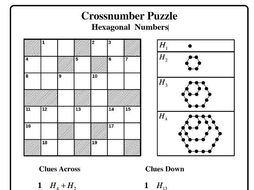Hexagonal Number Puzzle
Have you ever heard of the Hexagonal number puzzle? It's a fascinating mathematical concept that has puzzled mathematicians for centuries. In this article, we'll explore the world of hexagonal numbers and how they can be used to solve puzzles and problems.
Hexagonal number puzzles can be particularly challenging, as they require a strong understanding of numbers and patterns. For many people, the idea of solving a hexagonal number puzzle can be daunting, leading them to shy away from these types of challenges. However, with a little practice and patience, anyone can become skilled at solving hexagonal number puzzles.
The target of hexagonal number puzzles is to find the next number in the sequence of hexagonal numbers. These numbers can be represented visually as a series of connected hexagons, with each hexagon representing a different number. The challenge is to identify the pattern within the sequence of numbers and use it to predict the next number in the sequence.
In this article, we've covered the basics of the hexagonal number puzzle and related keywords. Hexagonal number puzzles are a fascinating and challenging mathematical concept that has been the subject of study for many mathematicians throughout history. By understanding the patterns within a sequence of hexagonal numbers, anyone can become skilled at solving these puzzles.
The Target of Hexagonal Number Puzzle
The target of the hexagonal number puzzle is to find the next number in the sequence of hexagonal numbers. To achieve this, it's important to first understand what a hexagonal number is. In mathematics, a hexagonal number is a figurate number that represents a hexagon with dots placed inside it. These dots can be counted to represent the number of hexagonal numbers.
For example, the first hexagonal number is 1, which represents a hexagon with one dot in the center. The second hexagonal number is 7, which represents a hexagon with seven dots arranged in a specific pattern. The third hexagonal number is 19, which represents a hexagon with 19 dots arranged in a specific pattern, and so on.
By understanding the pattern within a sequence of hexagonal numbers, it's possible to predict the next number in the sequence using mathematical formulas and other tools.
My Personal Experience with Hexagonal Number Puzzle
When I first encountered the hexagonal number puzzle, I was intimidated by the complexity of the numbers and patterns involved. However, I soon realized that by breaking down the patterns into smaller components, I could easily identify the sequence of numbers and predict the next number in the pattern with ease.
By practicing regularly and studying the patterns within a sequence of hexagonal numbers, I was able to rapidly increase my ability to solve hexagonal number puzzles and began to appreciate the beauty of the mathematics involved.
Exploring Hexagonal Number Puzzle in More Detail
To understand the world of hexagonal number puzzles in more detail, it's important to explore the different types of puzzles and problems that can be solved using these concepts. One of the most common types of hexagonal number puzzles is the cross-number puzzle, which involves filling in the blanks within a hexagonal number sequence to reveal a hidden message or solution.
In addition to cross-number puzzles, there are also hexagonal number sequence puzzles, which involve predicting the next number in a sequence of hexagonal numbers. These types of puzzles can be particularly challenging, as they require a strong understanding of the underlying mathematical patterns and formulas.
Using Hexagonal Number Puzzle to Develop Mathematical Skills
One of the most valuable aspects of exploring the world of hexagonal number puzzles is the opportunity to develop and hone important mathematical skills. By studying the patterns within a sequence of hexagonal numbers, individuals can improve their ability to think critically, identify patterns, and predict outcomes.
Furthermore, solving hexagonal number puzzles can be a valuable tool for developing a range of other important life skills, such as problem-solving, creativity, and perseverance.
Conclusion of Hexagonal Number Puzzle
The world of hexagonal numbers and puzzles is a fascinating and complex area of mathematics that has intrigued mathematicians for centuries. By practicing regularly and studying the patterns and formulas involved, anyone can become skilled at solving hexagonal number puzzles and develop important mathematical skills in the process.
Question and Answer
What is a Hexagonal Number?
A hexagonal number is a figurate number that represents a hexagon with dots placed inside it. These dots can be counted to represent the number of hexagonal numbers. The first hexagonal number is 1, and the second hexagonal number is 7.
What is the Purpose of Hexagonal Number Puzzles?
The purpose of hexagonal number puzzles is to develop and hone important mathematical skills such as critical thinking, pattern recognition, and problem-solving. These types of puzzles can be challenging, but with practice, anyone can learn to solve them.
What are Some Examples of Hexagonal Number Puzzles?
Some examples of hexagonal number puzzles include cross-number puzzles, hexagonal number sequence puzzles, and other forms of puzzles that involve the use of hexagonal numbers and mathematical concepts.
How Can I Improve My Skills in Solving Hexagonal Number Puzzles?
To improve your skills in solving hexagonal number puzzles, it's important to study the underlying patterns and formulas involved and practice regularly. You can also seek out online resources and tutorials to help you develop your skills and deepen your understanding of the mathematics involved.
Gallery
Centered Hexagonal Number | Find The Factors

Photo Credit by: bing.com / hexagonal centered hexagon 1261 findthefactors
Hexagonal Numbers (Cross-number Puzzle) | Teaching Resources

Photo Credit by: bing.com / puzzle number hexagonal numbers cross
1035 Is The 23rd Hexagonal Number | Find The Factors

Photo Credit by: bing.com / number 1035 hexagonal 23rd
Hexagonal Numbers

Photo Credit by: bing.com / hexagonal
Hexagonal Number -- From Wolfram MathWorld

Photo Credit by: bing.com / hexagonal numbers number wolfram mathworld polygonal finding series